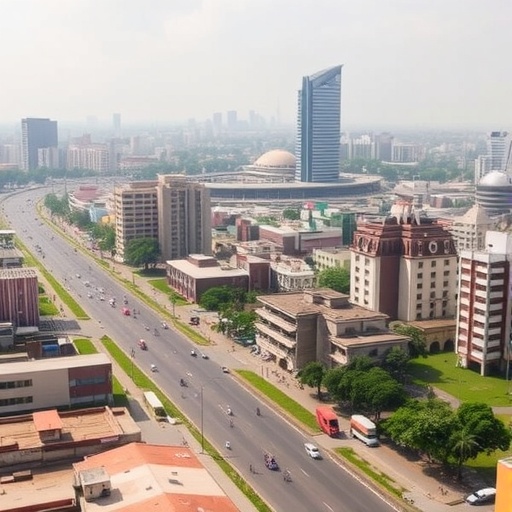In an era marked by rapid urbanization and its consequential impacts on the environment, understanding the dynamics of land use and land cover changes has become more critical than ever. The sprawling metropolis of Mumbai, India, is a case study that reveals the trends and ramifications of urban growth and the phenomena associated with urban heat islands. Researchers have employed a multifaceted approach to assess these dynamics, shedding light on the pressing need for sustainable urban planning and management.
Recent studies suggest that the urban landscape of Mumbai has undergone significant transformation over recent decades. The city, once characterized by natural ecosystems and green spaces, is now largely dominated by concrete structures and infrastructure developments. This metamorphosis has been driven by an increasing population and rapid economic growth, necessitating a thorough examination of how these changes impact local climates and environmental health. Land use changes in Mumbai are not merely a reflection of urban expansion; they substantially influence local temperatures and contribute to the urban heat island effect, a phenomenon that exacerbates heat retention in cities.
The urban heat island effect is particularly concerning in densely populated areas where vegetation is sparse. In Mumbai, empirical data indicates notable temperature discrepancies between urban and suburban zones, with the former exhibiting significantly higher temperatures. This is primarily due to extensive concrete surfaces that absorb and retain heat. As researchers have pointed out, integrating vegetation into urban planning could mitigate the adverse effects of this heat retention, contributing to a healthier urban environment. The connection between land cover changes and temperature increases presents a compelling argument for re-evaluating urban design strategies.
A comprehensive analysis of land use in Mumbai reveals a complex interplay between residential, commercial, and industrial developments. The encroachment of urban areas into previously natural habitats disrupts local ecosystems and diminishes biodiversity. The assessment highlights that, while urbanization can drive economic progress, it can simultaneously lead to environmental degradation. Hence, the challenge lies in balancing growth with sustainability. The necessity for urban planning policies that prioritize ecological preservation while accommodating the city’s expanding population cannot be overstated.
The study of urban heat islands emphasizes the role of urban forestry and landscape architecture in alleviating heat-related issues. Green roofs, urban parks, and tree-lined streets are not just aesthetic enhancements but are essential components of a sustainable urban framework. Such initiatives cultivate a microclimate that can reduce ambient temperatures and improve air quality. Moreover, adding green spaces has social benefits, fostering community interaction and enhancing the quality of life for residents.
Mumbai’s ecological footprint extends beyond its borders; the city’s land use decisions have implications for regional climate and environmental patterns. The increased demand for resources, spurred by urban migration, places immense pressure on surrounding rural areas. The balance between urban expansion and preserving agriculture and natural habitats is tenuous. Conservation efforts must be prioritized to ensure that the region’s ecological integrity is maintained. Policymakers are urged to recognize these interconnected systems and craft regulations that foster both urbanization and environmental stewardship.
Moreover, the dynamic nature of land use necessitates ongoing monitoring and comprehensive assessments. Geographic Information System (GIS) technologies and remote sensing play a pivotal role in facilitating this process. Leveraging these advanced tools allows researchers and urban planners to visualize changes over time, pinpointing areas needing intervention and resources. Such technological integration is vital in creating adaptive management strategies that can respond to the ever-changing urban landscape effectively.
To effectively mitigate the impacts of urban heat islands, community awareness and participation are paramount. Engaging residents in urban greening initiatives can foster a sense of ownership and responsibility towards their environment. Educational programs that inform citizens about the benefits of green infrastructures, such as lowered temperatures and improved air quality, can galvanize support for sustainable urban practices. Collectively, these efforts can cultivate a culture of environmental stewardship that transcends individual actions, leading to significant collective impact.
The implications of these findings reach far beyond Mumbai, resonating with global urbanization trends. As cities around the world grapple with the realities of climate change, the examples set by Mumbai may offer insights into managing growth sustainably. Understanding localized effects on temperature increases can aid in developing strategies applicable to other urban areas confronting similar environmental challenges. Thus, the lessons learned from Mumbai’s urban dynamics resonate on a universal scale.
The health implications of urban heat islands are profound. Increased ambient temperatures are linked to a surge in heat-related illnesses and mortality rates, particularly among vulnerable populations such as the elderly. Furthermore, the interplay between air quality and elevated temperatures raises alarms for respiratory health and overall public well-being. Effective urban planning must take these health risks into account, ensuring that cities are not just habitations but healthy living environments.
In summation, the assessment of land use and urban heat island dynamics in Mumbai necessitates a holistic understanding of urbanization’s intricate consequences. Moving forward, integrating environmental considerations into urban policy frameworks is critical. As cities evolve, so too must their approaches to sustainable development. The responsibility lies with researchers, urban planners, and policymakers to leverage this knowledge, ensuring that the expansion of urban territories does not come at the cost of environmental degradation or public health decline.
In conclusion, the burgeoning field of urban studies stands at a crucial crossroads, demanding innovative solutions to age-old problems. The case of Mumbai serves as a poignant reminder that the future of urban environments depends on how well we understand and adapt to the intertwined nature of development and ecology.
Subject of Research: Urbanization and its impact on land use, land cover changes, and urban heat islands dynamics in Mumbai, India.
Article Title: Assessment of land use land cover changes and urban heat island dynamics of Mumbai, India.
Article References:
Balasundaram, S., Singh, R.R., Asim, M. et al. Assessment of land use land cover changes and urban heat island dynamics of Mumbai, India.
Environ Sci Pollut Res (2025). https://doi.org/10.1007/s11356-025-36969-1
Image Credits: AI Generated
DOI:
Keywords: Urban heat island, land use changes, environmental sustainability, Mumbai, urban planning.




